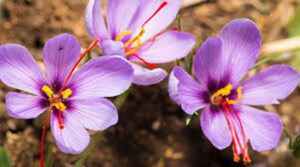By Debbie Roland and
Emmy Ulmschneider
Master Gardeners
If you ever sat down to a vibrantly colored Spanish paella, a Persian dessert, or a French bouillabaisse then you have tasted saffron! It is one of the most precious spices in the world, selling for $500 per ounce. The spice comes from the red colored stigmas (pollen bearing structure of the plant) which is why it is so expensive. It is a labor-intensive crop to grow and harvest. It can take 75,000 blossoms to produce one pound of saffron. The dried stigmas, called threads enhance the taste of seafood, meats, and desserts. Although expensive to buy, the good news is that you can easily grow it yourself!
Although its origin is unknown, perhaps Iran or Greece, recorded history beginning in 7th century BC tells us it was used medicinally and as a spice. Today, Iran produces 90% of the saffron. Saffron quality is graded in terms of strength and the amount of some of its unique chemical compounds. Some of these chemical compounds are antioxidants that protects cells against free radicals. Saffron grown in different areas is regionally distinct in color, taste, and quality.

Saffron, the plant, Crocus sativus, is a fall blooming crocus similar in look to the spring blooming ornamental crocuses you might already grow. It is hardy in USDA zones 5-8 and although we might not think so, it has a long history in the United States!
Saffron crocus grows well in our area. In its native area, very similar to the Californian chaparral, it prefers warm summers, sunny exposures and moist, friable calcareous soils with high organics. So, add lots of organic materials and irrigate your crocus beds or pots if you want to keep them happy. Many bulb companies have saffron crocus corms for sale so order early in time to plant them in August, at about 3-6” deep. Look for the leaves to appear in October and the blooms to appear in early November. Once they start blooming, check for blooms daily in the early morning before the bloom wilts. Pull of the red stigmas gently, (I use a pair of tweezers), and dry them away from high heat and light. I put the stigmas on a small, food prep saucer to dry quickly. The red stigmas, deteriorate in light or oxidizing chemicals so store them in an airtight container in the dark or best, in the freezer. Saffron crocus plants reproduce vegetatively so divide the mother corms about every three years to increase your plants or share them with a friend!
So, if you want a plant that is literally worth its weight in gold, has a long history in the United States and abroad and can satisfy your taste buds, then this is the plant for you!
If you have questions, please call the AgriLife office in Odessa at 498-4071 or in Midland at 686-4700 for more gardening information. Additional information is available at https://aggie-horticulture.tamu.edu and westtexasgardening.org.




